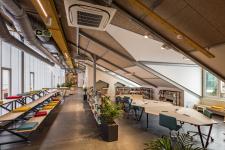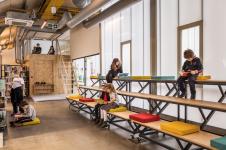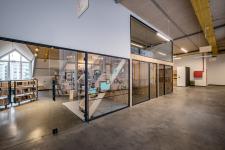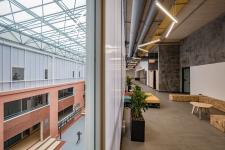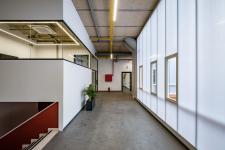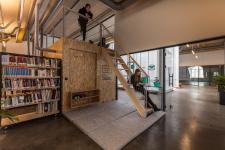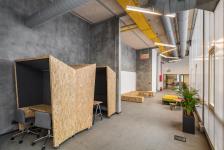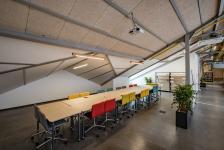Adopting Fuller's trimtab concept to build pedagogical labs in existing structures, Open Roof Space is a ‘beyond-classroom’ pedagogical space with a spatially hybrid program that fosters meeting, making, learning and working.
Open Roof Space was designed as a pedagogical space in an existing structure belonging to Private Sezin School in Istanbul. The project intervened in a lightweight yet effective manner and chose the formerly dormant empty rooftop space, measured at approximately 1700 m² within 15000 m². This scale difference allowed for experimentation while offering sufficient room for a critically diverse program.
The project has set a local example in terms of stakeholder engagement. Starting with a design thinking workshop in 2014, the seed of the project can be traced back to deep collaboration. ATÖLYE first developed a strategic spatial program for Private Sezin School, which included an unusually large teachers’ zone, a flexible events space, a public meeting room dedicated to educational NGOs to foster partnerships, a maker lab with three sections (media lab, woodshop, bio lab) and small lounge booths for comfortable parent-teacher dialogue. Such strategic programming ensured that the outcome would be novel independent from formal design elements. Furthermore, the layout and proximity of these different zones were informed by parameters such as need for daylight, visual privacy, acoustic isolation and persona-based circulation paths.
Architectural systems were developed in close synchrony with multiple technical specialists, leading to a high performance and integrated design. Ecological wood wool panels were placed across the ceiling surface to reduce reverberation and increase intelligibility in different learning settings, while serving energy efficiency goals. All lighting systems were specified as dimmable low-Kelvin LEDs, supporting flexible learning while reducing energy use. From daylight standpoint, a central atrium covered with sound-absorbing, low-embodied energy, lightweight polycarbonate panels provide ample daylight to spaces while narrow windows punctuate the surface creating shifting vantage points. Mechanical systems were selected with highest locally available efficiency ratings, while separating fresh air and exhaust air systems by coloring, thus serving as an educational vessel for children. Furthermore, the fresh air system was designed to capture excess heat from the enclosed courtyard using heat exchangers. A well-tuned building automation system was designed to capture the efficiency gains by integrating underfloor heating, VRV cooling, mechanical ventilation and operable windows.
From user experience standpoint, architectural nuances such as ample storage spaces for mobile furniture, wide corridors for spill-out usable spaces, no-shoe zones for informal interaction, elevated platforms for focused work, writable wall surfaces, and acoustic windows foster spatial diversity at large.
At the furniture scale, rather than moving forward with integrated systems, ATÖLYE developed its existing CNVS furniture line with new modular and flexible products. Ranging from a stage seating on wheels to acoustically isolated hub structures, from mobile bookshelves to stand-up work tables, the bespoke furniture portfolio allows for permutational layouts. In a way, the furniture system suggests all users to become actants rather than passive observers or victims of context. As a proxy, when designing the space, three distinct layout configurations were explored to optimize the modules’ pattern language, however, dozens of alternative scenarios are likely.Meanwhile, the lighting units in the event space were designed, prototyped and manufactured in collaboration with a select student group, thus setting a visible example of ownership-via-participatory design.
Furthermore, the design team optimized teachers’ zone by developing a personalized desk separators rather than private desks, which diminished the space need by 35% while increasing likelihood of interaction among teachers. All furniture was manufactured within 50 km of the site, while utilizing FSC-plywood, low-impact felt, recycled sponge and recycled steel.
Throughout the research and schematic design phase, frequent site visits, passive observation sessions, interviews and design crits ensured proper prioritization of design tactics. ATÖLYE also engaged Education Reform Initiative, a leading NGO, in the design phase, thus sparking institutional collaborations which will help scale this space’s impact to other schools. During construction, the project team decided to leave the space partially incomplete in terms of furniture and machine infrastructure thus learning from its first six months and enabling an iterative process.
The Open Roof Space Impact Assessment that took 6 months after the partial completion of the project, aimed to measure the effectiveness of different areas in the Open Roof Space and measure the spaces impact on the user’s behaviour. ATÖLYE conducted concise workshops with 40 students to discover the opinions and ideas of students regarding space and the way they are used. With an interactive plan study that was located in the school for a week, more than 100 students ideas were harvested. In addition to these methods, the project team examined the outcomes of a school-wide questionnaire conducted with teachers and studied the photos from the activities held within the different areas of the Open Roof Space.
As a result of analysing all these inputs, ATÖLYE created flexible spaces with the aim to meet the different needs and expectations of teachers and students. ATÖLYE designed three new classes in the concepts of “a space that facilitates alternative learning and working styles”, “a space that allows information sharing” and “a space that aims to spread the culture of production to the entire school”.
2016
2017
Berna Erenoğlu, Engin Ayaz, Nesile Yalçın, Begüm Ural, Elif Karaköse (Design Team)
Berna Erenoğlu (Project Lead)
Ece Çiftçi, Şevval Ceylan(Graphic Design)
Ayşe Esin Durmaz(Prototyping)
Burak Koçak(Separator Design)
Ali Arslan, Lola Kotilov (Intern)
Total Teknik (Mechanical), Sinapsen Elektrik (Electric), Doruk Mühendislik (Structure), Saf Mühendislik (Acoustics Consulting), Serdar Selamet (Fire Consulting), Katı Hal (Hardware Prototyping), Seçkin Maden (3D Visualization), Yerçekim (Architectural Photography), Özgür Önurme (Video), Artika (Contractor)

